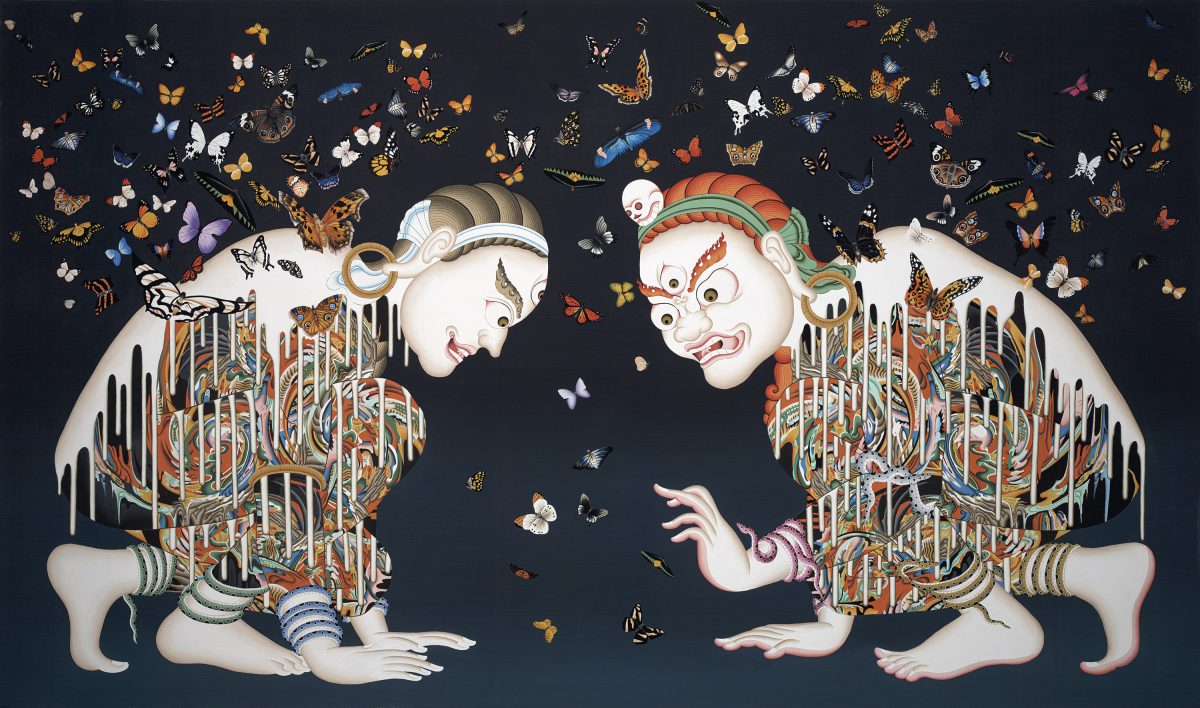When the five lights of brilliant wisdom dawn,
Fearlessly, bravely, may I know them as myself!
When the forms of the Lords mild and fierce arise,
Bold and fearless, may I recognize the between!
-The Tibetan Book of the Dead
In Tibetan Buddhism, the intermediate state between death and rebirth is known as the bardo — The Between. What is commonly referred to as the Tibetan Book of the Dead is more accurately translated as Liberation Through Understanding in the Bardo, and it serves as a kind of guidebook for souls that find themselves wandering realms of fearsome and benevolent deities. Its purpose is to remind them that whatever entities they encounter, whatever terrors or easy comforts may come, are projections of their own mind.

The VMFA’s Tsherin Sherpa: Spirits is a mid-career retrospective that elucidates artist Tserin Sherpa’s artistic, cultural, and biographical journey in poignant narrative. Curated in revelatory fashion by John Henry Rice, Sherpa’s work populates these seven distinct sections with spirits that are at once imbued with the inherent dignity of Tibetan Buddhism’s iconic spiritual imagery, yet also at varying stages of diasporic confrontation with western culture and commodification. In sequence, they tell a story of loss, struggle, empowerment, and ultimately a serenity born of the experience and transcendence of turmoil.

A Nepal-born artist of Tibetan descent, Sherpa was trained from a young age in traditional Buddhist artforms. It wasn’t until he arrived in the US less than 25 years ago that he was exposed to modern art. “Growing up in Nepal, we didn’t have any museum culture. We had almost no gallery existence, and the only artwork, the only accessibility of the artwork, was this traditional artwork that you see everywhere,” Sherpa says. “So once I arrived in America, for the first time I got the opportunity to go to a museum here, in San Francisco. And then I saw all of these traditional artworks put up in a museum. I had to pay for a ticket to go and see these. So this is what actually generated respect for my own heritage and tradition. It was a whole cycle.”
Enamored with a new world of galleries, and exposed to an overwhelming flood of artistic expression, his early work reflects a wavering identity caught between the negotiations of heritage and pop culture. Largely devoid of the innate balance that characterizes his contributions to the VMFA’s Awaken exhibit, these first pieces capture dissonance and disquiet; the uncomfortable comedy of something personally essential sandblasted by a culture of branding and loaded imagery.

As the exhibit progresses, the spirits develop a more complex identity of their own, emerging victorious from the cacophony of geopolitical conflict and the war between defiance and assimilation. It’s here we begin to see colorful distortions of Tibetan deities swirling around Sherpa’s figures, as though an energetic force is animating their triumphs.
The final three sections of the exhibit form a kind of sanctuary, as though the tenor of the museum itself has been transmuted in the presence of the spirits’ self-actualization. Following their victory, the spirits blossom into a state of fluid consciousness, emanating not just peace, but the childlike wonder that had been buried under their previous struggles.

A standout piece, The Wish-Fulfilling Tree, is one of three sculptures in the show. A metal seven-layer mandala sprouting from a pile of rubble, it was created in the aftermath of the 2015 earthquake in Nepal. The debris at the base is sourced from the locations to which it travels, and in Richmond has come from the VMFA itself, old buildings demolished in the name of urban renewal, and rubble from the fall of the Robert E. Lee monument. An interactive piece, viewers are invited to write their wishes on pieces of paper that are then periodically collected and inserted into the mandala itself.

For Sherpa, it’s not the only interactive piece in the exhibit. “I don’t try to influence the viewer so much with the stories that I have in [the paintings],” he says. “At first glance I would really appreciate if my viewer actually looks into the work, and based on her or his experience, interprets something out of it. So that becomes interactive, that becomes more; they have their say in the work. And it becomes something new.”
While his work may be formally specific to the experiences of the Tibetan diaspora, there is a universality to these pieces. Their relevance reaches past their stylistic influences and speaks to the archetypal narrative of searching for the self in a foreign place — in service not of enlightenment, but of finding some kind of home.

“Basically I was not even creating [a] religious icon,” Sherpa says. “This is a spirit, which is a character, which is kind of like a modern version of a superhero that the Himalayan people can relate to. It’s kind of like a collective mental attitude. A collective imagination.”
As younger generations within the Himalayan population pull away from the rigidity of artistic and religious traditionalism, Sherpa’s spirits carry those traditions into a broader cultural conversation, an act of preservation by way of deconstruction. “I call them two vehicles — it is very very important,” Sherpa says. “And that’s why even though my practice is creating these new icons, new language to communicate with the audience, be it in Nepal or here in the west, or worldwide, simultaneously my energy is so much focused on preserving tradition in Nepal. This whole tradition, which is over a thousand year old tradition, is disappearing slowly.”

Tsherin Sherpa: Spirits doesn’t just capture the story of the diasporic consciousness, or the struggles of an artist in exile; it is a celebration of Sherpa’s elevation to the realm of the true visionary — the artist whose work inspires reflection, understanding, and ultimately acceptance of our human selves and the various realities we encounter. These are not icons of ascended beings, not Buddhas built for emulation along the path to enlightenment. They are as worldly and human as they are mystical and sacred, at once gods of the Tibetan diaspora, and the story of human history — a moment in which Tsherin Sherpa is asking us to recognize his spirits as projections of our own minds.

Tserin Sherpa: Spirits is currently on display at the Virginia Museum of Fine Arts, and will remain on display until October 16, 2022. Tickets are $10 for adults, $8 for students, youth, and seniors. They can be purchased at the VMFA’s website.
Top Image: Spirits (Metamorphosis), 2019–20, Tsherin Sherpa, acrylic and ink on canvas. Collection of Dolma Chonzom Bhutia.



